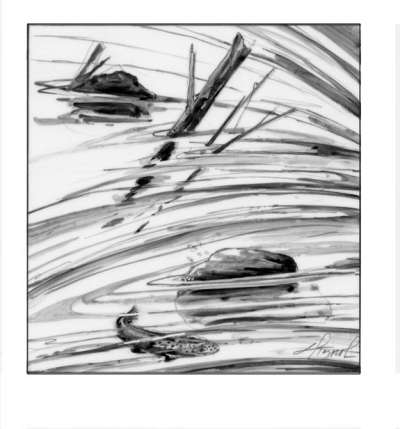
There were times, during Tropical Storm Irene, when the rivers in Vermont and New Hampshire seemed to be made out of something other than water. Whatever it was was viscous and liquid, sure, but that roiling, furious, chocolate-colored mass was unlike anything many of us had ever seen before. When we talk of river water we usually use words like “sing;” river stewards have been known to take things to worshipful extremes and use words like amniotic. But this. This fecal, angry substance carrying cars and horizontal trees was something else entirely.
Watching the raw power of the river water in the aftermath of Irene, it was impossible not to think of the animals that live there. How, on earth, could a trout survive? If each foot of rising water produces 500 pounds of lateral force, then wouldn’t every single living thing be swept away in such a torrent?
Talk to a fisheries biologist and you’ll learn that the answer is “no, but.” The no part can be chalked up to physics, among other factors. A trout’s streamlined shape minimizes resistance, and its slimy epidermis cuts down on water friction. They hug the bottom of the stream during a flood, where things are slower and less turbulent than higher in the water column. They hide behind rocks and snags and in pockets inside stream banks where the natural structure decreases the velocity of the water, much as humans might use a building as a windbreak. And when all else fails, they get out of dodge and seek slower water outside the stream channel, a move that can lead to stranding if the water level drops too quickly.
The ‘but’ part of the answer reflects the fact that some fish don’t make it. Biologist Rich Kirn, with the Vermont Fish and Wildlife Department, says that with a normal-sized flood he’d expect to see some decline in fish stocks, but Irene was above and beyond normal. Vermont has monitored fish populations at stations throughout the state for the past few decades. Kirn says that biologists have already noticed some decline in salmonid populations due to the spring flooding in northern and central areas of the state, and expect to see more in the wake of Irene. Fortunately, Irene’s flash flooding was late enough in the year that the hatchlings stood a fighting chance. Late spring floods in May and June can be especially hard on trout populations, as the just-hatched fry are especially vulnerable.
When the animal life in a river will recover depends on how much damage occurred. In areas where the riparian vegetation was wiped out and the river channel inundated with sediment, or conversely, scoured raw, it might take years, if not decades. New Hampshire fisheries biologist Jason Carrier points to the Nash Stream in northern New Hampshire – where years of poor river management, coupled with a dam break and subsequent flood in 1969 left the river in a moonscape condition – as an example of a catastrophic flood we’re still recovering from. New Hampshire Fish and Game, Trout Unlimited, The U.S. Forest Service, and dozens of local environmental and civic groups have chipped in tens of thousands of dollars towards streambed restoration efforts on Nash Stream; trout habitat is being improved by putting logs, root balls, and large boulders back into the sterile channel.
There’s a paradox and a silver lining in that last line. Both Kirn and Carrier point out that in areas that weren’t catastrophically damaged, the floods associated with Irene could help trout populations in the long run. Floodwaters can scour stream bottoms and enhance spawning areas, as cleaner gravel equates to higher hatch rates. And as the downed trees and debris become incorporated into the stream channel, the surviving trout will flock to the new structures. While it’s disheartening to consider the short-term mortality, a flood of this magnitude is a great example of nature’s penchant for regeneration through violence. Like a forest fire wiping the slate clean and allowing a pitch pine forest to start all over again, so does a flood rejuvenate a river.
Kirn says that whatever the horror of Irene, the fish and freshwater invertebrates will bounce back. “New England’s a rough place to live for any fish,” said Kirn. “You’ve got anchor ice and ice jams to contend with in winter; floods every spring; heat and low flow in the summer. But the fish have adapted to it. They take a hit and come back.”


Discussion *